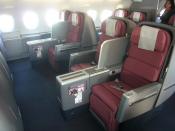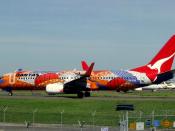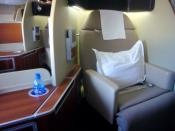1Profile of Qantas
The Qantas Group has a long history in the Australian airline industry. It began its operations in 1920 as the second oldest airline in the world. Passenger and mail services started in 1920. When the Australian Government bought Qantas in 1947 to operate as the nation's flag carrier, Qantas was restricted to flying only internationally, while the domestic market was heavily regulated.
After deregulation of the industry in the early 1990's, Qantas was able to re-enter the domestic market in Australia.
Through continual restructuring and reorganisation, the Qantas Group is changing to reflect the demands of the market and keep the business profitable by generating revenue from various business areas. As well as operating the core flying business, Qantas operates a number of profitable subsidiaries to support the airline.
The core flying business of the Qantas Group includes Qantas, for the business and full service economy traveller, QantasLink, for the regional flyer, Australian Airlines, for the leisure market in Asia and Jetstar, for the low-budget traveler.
Qantas operates carriers to cater for various segments in the market, rather than concentrating on one brand to appeal to many.
It has also been announced that Jetstar International will begin operations late 2006, with flights to start in major cities in Asia. This carrier will replace Australian Airlines and will extend the domestic Jetstar network in Australia (Media release, Jetstar Web site).
Qantas also operates Flying Services Businesses and airline-related businesses. The Flying Services Businesses consists of the Qantas Engineering Technical Operations and Maintenance Services (ETOMS), one of the largest aircraft engineering and maintenance organisations in Asia-Pacific (Galvin, P., & Twyonials, S., 2005). Airports and Catering are also successful subsidiaries.
Associated airline businesses include Qantas Freight, including a joint venture with Australia Post, the wholesale holiday sales groups of Qantas Holidays and Viva Holidays and Qantas Defence Services, the aircraft maintenance group for the Defence force.
The current leaders of the airline are Geoff Dixon, Chief Executive Officer and Managing Director since 2001, Peter Gregg, Chief Financial Officer and Margaret Jackson, Chairman. There are also a number of Independent Non-Executives including James Packer and General Peter Cosgrove.
The Qantas Group is successful and profitable, posting reports of after tax profit for 11 years. The last financial year 2004/2005 generated $1027.2 million before tax, $763.6 million after tax.
2Qantas's External Environment
2.1The Industry environment
The five forces model, (Porter, in Hill, Jones & Galvin 2004) is a framework to analyse competitive forces in an industry environment. These forces are: the threat of new entrants; the degree of rivalry between companies in the industry; the bargaining power of buyers and suppliers; and the threat of substitute products (Hill et al, 2004 p.71).
The threat of new entrants depends on the barriers to entry to the industry. High barriers make it costly for a new entrant to begin operations. In a review of the issues prevalent in the Australian air industry, the authors' remark, "High capital and set-up costs have traditionally contributed to high entry costs and have increased the market power of the incumbent airlines..." (Kain and Webb, 2003). The high barrier to entry impedes competition between established airlines. Even after the liberalisation of the industry in Australia, where new entrants can gain access to airport space, operate on major domestic routes and start a new airline with a relatively small start-up cost through equipment leasing, economies of scale seems to be a major factor contributing to the lack of new entrants and competition.
Other factors affecting entry costs are brand loyalty, cost advantages and economies of scale (Bain, in Hill et al, 2004 p72). Qantas is still considered to be Australia's national carrier, so it holds considerable brand loyalty with customers domestically and internationally and marketed as the "flying kangaroo." Absolute cost advantages are made through superior product operations through Qantas's experience over many years and control of production inputs such as labour, materials sourced through better deals and buying leverage, and management skills. Qantas also maintains an efficient and extensive network of domestic and international routes, while giving passengers the ability to use other carriers in the One World alliance, a strategic partnership between selected carriers.
The entry of low-fare carriers into the global airline industry reflects an "emphasis on aggressive containment of costs to sustain highly competitive fare levels" (Kain et al. 2003). Virgin Blue has been the first successful low-cost entrant in Australia, following the Qantas acquisition in 2001 of the short-lived Impulse Airlines. The new low-cost entrants injected competition into the long-lived duopoly held by Qantas and Ansett after deregulation. This intensified competition in the industry and caused an industry shakeout of Ansett Airlines. With the rise of low-fare carriers, company rivalry has increased and strategic groups have formed. The rivalry between strategic groups is less than that experienced between members of a group (Hill et al. p 71). When Virgin Blue begun its operations on major domestic routes, Qantas entered a price war to regain the market share it had lost to the competitor.
In the five forces model, Porter argues that the bargaining power of buyers and also the bargaining power of suppliers are competitive forces that can affect profits. In the case of fuel, Qantas is a price taker as it has no choice but to buy the fuel at the rate set by the supplier (Hill et al, 2004 p80).
Air travel in Australia now competes directly with substitutes such as rail, coach and car travel. Australia is unique in that the "market for air transport... is disproportionately large" (Galvin et al. 2005). As distances between most capital and major regional cities are large, the alternative modes of transport are not realistic transport substitutes for the majority of travellers.
2.2Qantas and the Macro environment
New security measures that have arisen from terrorist threats, increases in aviation insurance costs and reductions in consumer air travel are strains that have cased many carriers to cease operations due to financial hardship and bankruptcy. The macro environment forces that may affect Qantas are: Socio cultural, Technological, Economic, Political and Regulations.
Australia's workforce today is a more mobile one, with an increasing need for employees to fly to national offices for business. This leads to an increased demand for point-to-point travel between major cities. However, a recent study done by Tourism Australia to promote local tourism showed that Australian's are far less likely to travel for leisure, citing workplace barriers and increased work pressures as reasons for not travelling (Tourism Australia, 2006). The threat of a decline in leisure travel will adversely affect both the domestic and international networks of Qantas.
Technology forces affecting Qantas are the advances in equipment and the availability and use of enterprise-wide software systems and Web technologies. The development of new and better aircraft allows Qantas to use bigger and more cost-efficient planes on routes. Since Virgin Blue's withdrawal from the Sydney-Canberra route, Qantas has been able to expand their capacity. Qantas have recently announced that the new aircraft Bombardier Q400 with its "jet-like speeds as well as increased passenger comfort" will be used on this route (Qantas Newsroom, May 2006). Economic forces impacting Qantas include oil price fluctuations and the impact on fuel prices, with the real threat of increased operating costs.
The domestic Australian air industry was deregulated from 1990 to 1992, when the government liberalised the domestic market. Qantas and Australian Airlines were privatised, and Qantas was allowed to re-enter the market and operate a domestic network. From 1992 to 1995, deregulation of international airlines and airline privatisation occurred. This allowed carriers such as Ansett to enter the international market. The international market is gradually being further liberalised as the Government seeks to intensify competition to keep the industry fair. Singapore Airlines, the premium national carrier of Singapore, is seeking approval to operate on the Sydney to Los Angeles route. This route already has an overcapacity of carriers operating on it. Further competition and new entrants on the route could cause an industry shake-out. Further regulatory frameworks such as bilateral agreements further inhibit complete liberalisation of the industry.
3Qantas's Strategies
Competitive advantage is defined as the ability of a company to outperform its rivals, commonly measured by superior performance and the 'attainment of above-normal profits.' (Hill, Jones & Galvin 2004, p. 110). The building blocks of competitive advantage are efficiency, quality, innovation and responsiveness to customers (Hill et al., 2004). These factors are interrelated and the extents to which a company can deliver on these factors determine business success. To create value in their product, Qantas have fulfilled these factors successfully. Qantas have gained competitive advantage by building up a strong brand image, an extensive network of domestic and international routes and an impeccable safety record.
Qantas's strategies have changed significantly since the 1980's because they have had to compete in the market since 1995 without government financial assistance. When the Australian Government deregulated the air industry, Qantas was already in a strong position. It had the competitive advantage of being Australia's national carrier, operating an international network and controlling all of the previously Government-owned Australian Airlines domestic services. The arrival of Compass Airlines, the first no-frills service to enter the market, caused competition and decreased average airfares (Galvin et al. 2005).
When Virgin Blue entered the market and Ansett Airlines collapsed, Qantas became the only carrier to offer a full domestic service. The arrival of Virgin Blue had an impact on Qantas's market share and profits, and Qantas was forced to match low fares to operate at better capacity.
In 2004, Qantas launched Jetstar, essentially a copycat of other low-cost carriers such as Virgin Blue (Hall, J., 20 Mar 06). It competes directly in the budget air travel market and has only the one competitor. Jetstar operates on a lower cost model, where labour, maintenance and "no-frills service" contribute to a lower cost base. Jetstar Asia is a low-cost carrier Singapore-based venture, in which Qantas has a 45 per cent stake. The carrier is intended to be a budget carrier to tap into the highly lucrative market of Asian leisure travel. At this time however, Jetstar Asia is struggling to fill capacity (Business, The Age 26 Apr 06) and is likely to be merged with Jetstar International late in 2006.
Low-fare carriers are able to access a larger market segment as these customers are convinced that budget travel has more value for money than services provided by premium carriers such as Qantas. E-business and clever marketing strategies have allowed airlines like Jetstar and Virgin Blue to be successful, with customers willing and able to try budget travel. Low fares increase market share and demand, as the lower cost of air travel makes it within reach to more of the population. Jetstar increases market share of the Qantas Group without jeopardising the Qantas premium brand.
Market segmentation is the "process of subdividing customer groups based on customer preferences" (Hill et al. p 192). Qantas has developed a number of carriers to reach more market segments.
The Qantas Group operates Jetstar on a focused cost-leadership strategy. This strategy is based on operating in a single segment of the market (Hill et al. p 201), where low priced products are offered to one group of customers. The Qantas brand is a focused differentiation strategy, focusing on the segment of the market that wants premium services.
As well as establishing a low-cost carrier, Qantas continues to benefit from expanding and seeking efficiencies in its business segments. The airline is looking increasingly at diversifying outside of traditional airline operations to grow revenue (Hall, J., 21 Apr 06).
3.1Recommendations
It is recommended that Qantas continue to operate with its core strengths in mind. With the rising oil prices, Qantas has introduced a "Sustainable Future Program" with plans to cut $3 billion from the Qantas cost base by June 2008 (Hall, J., 21 Apr 06). Cost improvements are expected in the areas of labour productivity, fleet simplification, distribution initiatives and improvements in overheads (Galvin et al. 2005. P C17).
Fuel and labour comprise 60 per cent of Qantas's costs (Hall, J. 21 Apr 06) and as the price of fuel can't be changed, Qantas will need to start cutting labour costs. Evidence of this has been seen in the recent redundancies of 340 employees in the Sydney heavy maintenance base, as Qantas seeks to consolidate the group in Avalon, Victoria. Further cost cutting is expected to affect pilots wages. Currently, Qantas pilots are paid more than half of what Jetstar pilots are paid. With the possible introduction of Jetstar International, Qantas hopes that the new carrier can take over many of the routes run by Qantas. It is recommended that Qantas decrease pilot's wages and further consolidate maintenance bases.
There was discussion about sending jobs offshore to cut costs, though Qantas has decided against this for now after the backlash from unions and employees, to the disappointment of some financial analysts (AFR 22 Mar 06). The trend for companies to send jobs offshore is increasing (Spicer, R. 2006) and it is definitely a good option for Qantas to consider in the next two to three years once Jetstar International is established, generating profit and a substantial restructure of the Qantas Group has occurred.
Qantas currently have a 50 per cent stake in the land freight group, Star Track Express, with views to expand in the land transport industry in Australia. Extensive discussions have taken place between Queensland Rail and Qantas, to assess a possible rail-freight joint venture. Toll is a major customer of Qantas Freight, and with the imminent Toll-Patrick merger, Toll is expected to move its business to Virgin Blue, the domestic airline controlled by Patrick Corporation (Hall, J., 19 Apr 06). It is recommended that Qantas expand their national logistics network by forming a joint venture with Queensland Rail and then acquiring a road logistics group to complete a national logistics corporation to rival the possible Toll Holdings group. This distribution strategy will ensure that Qantas's airfreight business will still be profitable from continued business alliances.
Business process outsourcing, though sometimes over hyped, can be viable cost option for simple bulk processing transactions and could be a useful cost-cutting solution for Qantas. Business functions such as accounts, human resources, property management and marketing are all non-core competencies. Outsourcing these functions leads to more efficient workflow - by allowing "experts" to take over when needed - and the ability to concentrate on core competencies.
4References
Creedy, S., 2006. Jetstar recalls Ansett's air force. The Australian. 5 May 2006.
Creedy, S., Qantas threatened by worker revolt. The Australian 17 March 2006.
Galvin, P., & Tywonial, S., 2005, Qantas: the high-flyer of the airline industry?, Case study 7 on the textbook website.
Hall, J., 2006. Qantas to wield axe as profit slides. The Australian Financial Review 17 February 2006.
Hall, J., 2006. Qantas warns its pilots of a hard landing. Australian Financial Review 16 March 2006.
Hall, J., New freight ventures on the way. The Australian Financial Review 19 April 2006
Hall, J., No Frills, we're Jetstar. AFR Boss Magazine 20 March 2006
Hill, C.W., Jones, G.R. & Galvin, P., 2004. Strategic Management: An Integrated Approach. Milton, Qld: John Wiley & Sons Australia.
Kain, J., Webb, R., 2003. Turbulent Times: Australian Airline Industry Issues 2003. Parliamentary Library. http://www.aph.gov.au/LIBRARY/pubs/rp/2002-03/03RP10.htm
King. A., Qantas revises flight path of computer strategy. The Australian Financial Review 21 March 2006.
Qantas Newsroom Web site. April 2006. Qantas Group International Networks. http://www.qantas.com.au/regions/dyn/au/publicaffairs/details?ArticleID=2006/apr06/Q3418
Qantas Web site. http://www.qantas.com.au/ : site last accessed 3 May 2006
Rochfort, S., 2006. Qantas rides through storm: slashed expenses help airline to cope with fuel prices. The Sydney Morning Herald 17 February 2006.
Spicer, R. May 2006. Insight into Outsourcing. Dynamic Business for Growing SMEs, Loyalty Australasia Publication.
Street Talk. 2006. Fly-buys: MacBank to see who wants seats. The Australian Financial Review 22 March 2006.
Tourism Australia. 2006. No Leave, No Life - Australian employees stockpile 70 million days of Annual Leave http://www.tourism.australia.com/NewsCentre.asp?sub=0315&al=2226 : site last accessed 3 May 06
Virgin Blue Web site. http://www.virginblue.com.au/ : site last accessed 3 May 2006



Improvements: Why the response lost marks
I forgot to add the comments given when graded:
Profile section:
- Should have included more details such as financial ratios and airline metrics.
- Size of Qantas
- Revenues of Qantas
External Environment
- Include more detail pre and post regulation of industry
- Not discussed bargaining power of buyers and suppliers (ie. airports) adequately.
Macro environment:
- Need to discuss economic reasons (reasons for travel demand increase), demographic changes, technological changes, business versus leisure traveller.
Strategies:
- Cut operating costs
- Codesharing
- Outsourcing
- Jetstar
- New aircraft acquisition
- Hedging fuel costs
- Safety record
- Should have classified strategies such as cooperative strategies
General:
Should have attempted to answer the case questions in the concluding remarks.
2 out of 2 people found this comment useful.